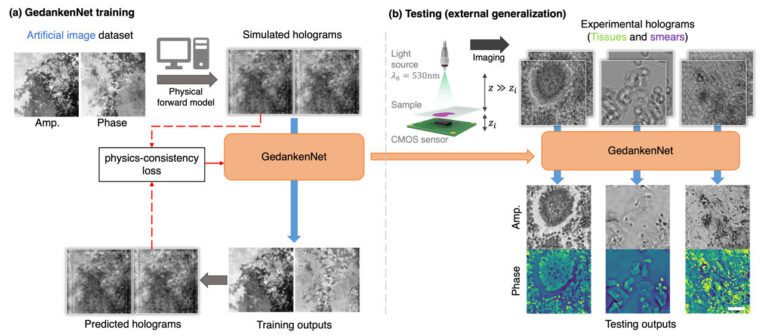TL;DR:
- UCLA engineers present a novel AI model for computational imaging and microscopy.
- GedankenNet, inspired by physics laws and thought experiments, learns without real data.
- Conventional AI microscopy faces challenges in data reliance and adaptability.
- GedankenNet generates microscopic images from imagined holograms without prior data.
- AI model’s “thought training” successfully reconstructs human tissue images.
- GedankenNet outperforms existing models in adaptability and physics-aligned output.
- Ozcan highlights the potential of self-supervised AI for physics-based learning.
- Market impact: Potential for widespread adoption of physics-compatible AI models.
Main AI News:
The landscape of technological innovation continues to expand as researchers from the prestigious UCLA Samueli School of Engineering introduce a groundbreaking artificial intelligence (AI) model that is poised to redefine computational imaging and microscopy. Departing from conventional methodologies that necessitate training with physical specimens or empirical data, this pioneering approach leverages the power of self-supervised AI, showcasing the remarkable potential of merging AI with the principles of physics.
This revolutionary advancement comes to light through a recent publication in Nature Machine Intelligence, authored by the esteemed Volgenau Professor for Engineering Innovation, Aydogan Ozcan, and his accomplished research team. Their brainchild, affectionately termed GedankenNet, stands as a testament to the prowess of harnessing AI’s learning capabilities in conjunction with the tenets of theoretical physics and intellectual contemplation.
While AI’s transformative impact on diverse domains, spanning photography to sensing, is widely acknowledged, its integration within the realm of microscopy has faced persistent challenges. Conventional AI-driven models have traditionally relied heavily on human oversight and extensive datasets, mandating arduous and resource-intensive experimentation with copious samples. Additionally, these models often falter when confronted with novel sample types or experimental configurations.
Inspired by the intellectual legacy of Albert Einstein’s Gedanken experiment, a method that propelled the theory of relativity into existence, the UCLA team embarked on a journey to create GedankenNet. Rooted in the fundamental laws governing electromagnetic wave propagation in space, the researchers meticulously educated their AI model to meticulously reconstruct microscopic images using artificial holograms conceived entirely from the realms of imagination. Eschewing reliance on real-world data or tangible sample resemblances, GedankenNet derives its efficacy solely from the realm of theoretical thought.
The crux of GedankenNet’s training lies in its meticulous honing through “thought training.” Following this preparatory phase, the AI model underwent rigorous evaluation utilizing 3D holographic representations of human tissue samples—a feat facilitated by a novel experimental apparatus. In its inaugural endeavor, GedankenNet astoundingly succeeded in reconstructing intricate microscopic images of human tissue samples and Pap smears, sourced solely from holographic data.
Directly contrasting with conventional image reconstruction techniques hinged on supervised learning and voluminous experimental data, GedankenNet demonstrates unparalleled adaptability to unobserved samples. Strikingly, this feat is achieved devoid of any reliance on empirical data or prior sample information. Beyond its superior reconstruction capabilities, GedankenNet produces output light waves impeccably aligned with the underlying physics of wave equations, faithfully depicting the 3D journey of light within space.
“In these findings, we witness the profound potential of self-supervised AI to emulate the very thought experiments that drive scientific inquiry,” affirms Ozcan, a luminary with faculty affiliations in the Electrical and Computer Engineering and Bioengineering departments at UCLA Samueli. He asserts that this groundbreaking advancement heralds fresh prospects for the creation of AI models harmonizing with the tenets of physics. With the ascent of GedankenNet, an avenue emerges for cultivating neural networks that embrace physics compatibility, ease of training, and broad applicability—a compelling alternative to the prevalent supervised deep learning approaches found in diverse computational imaging domains.
Conclusion:
The unveiling of GedankenNet by UCLA engineers marks a significant leap in computational imaging and microscopy. By integrating self-supervised AI with the principles of physics, this breakthrough challenges traditional reliance on data-heavy approaches. The potential of GedankenNet and its alignment with physics principles not only augments microscopic image reconstruction but also hints at a transformative shift in the market. The advent of physics-compatible AI models could pave the way for innovative applications across diverse computational imaging domains, enhancing both efficiency and precision.

